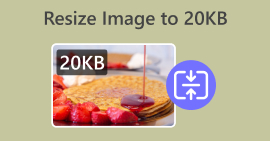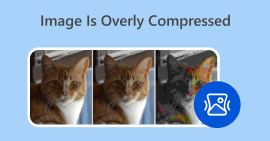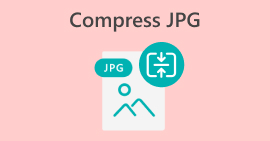Photo Compression Ratio: Compress Your Images Efficiently
When it comes to image compression, it’s important to understand the concept behind compression ratio. While it may be a common term, it’s always misunderstood and taken differently into another context. For instance, users assume that they can always achieve the same quality output of a compressed image and can expect a significant loss in size when using a low compression ratio. The thing is, it depends on the compression ratio and the type of compression being utilized.
To gain a comprehensive understanding of photo compression ratios and effective compression methods, read this article and immerse yourself in what it means by photo compression ratio, as well as the methods on how to change them. Get yourself prepared and learn how to compress your images efficiently.

Part 1. What is Photo Compression Ratio
The photo compression ratio is the ratio of the number of bytes in the uncompressed photo to the number of bytes when compressed. In the simplest explanation, it refers to how much smaller a photo file becomes compared to its original size. So, when a photo has a high compression ratio, it means that the photo can be reduced to a smaller size, which can make it look blurry or pixelated. Meanwhile, when a photo has a low compression ratio, then the photo had only a small size reduction on the photo that was compressed. To better understand this, here is a comparison to what is lossy vs. lossless compression.
Lossy Compression
This is a type of image compression where a photo can significantly reduce its size and quality. It means that the photo has a high compression ratio. For example, when a photo has an original size of 10MB and was compressed to 500KB which means it achieved a 20:1 photo compression ratio.

Advantages:
• Significantly reduces file size.
• Ideal for web usage.
Disadvantages:
• Loss of image quality, especially in high compression levels.
• Not suitable for images requiring exact reproduction of original data.
Lossless Compression
Compared to lossy compression, this type of compression means there is no loss of information, and the image quality remains exactly the same as the original.

Advantages:
• No significant loss of image quality.
• Suitable for images requiring high fidelity.
Disadvantages:
• Less file size reduction.
Part 2. How to Change Compression Ratio on Photo
Adjusting the compression ratio of an image helps achieve the right balance between its quality and file size, ensuring that it looks great while taking up less space. To achieve this, you can use Photoshop. This tool allows users to perform a wide range of image editing tasks, including adjusting the photo compression ratio. With this particular feature, you can fine-tune the image quality to meet specific requirements. Here’s how you can use Photoshop to change the compression ratio of your photo:
Step 1. First, import the image file that you want to change the compression ratio by going to the File tab and clicking the Open option.
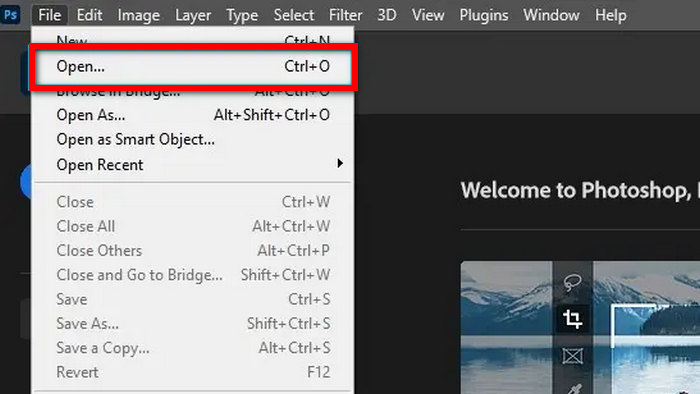
Step 2. Once you have your photo imported in Photoshop, go to the Image tab and click on the Image Size.
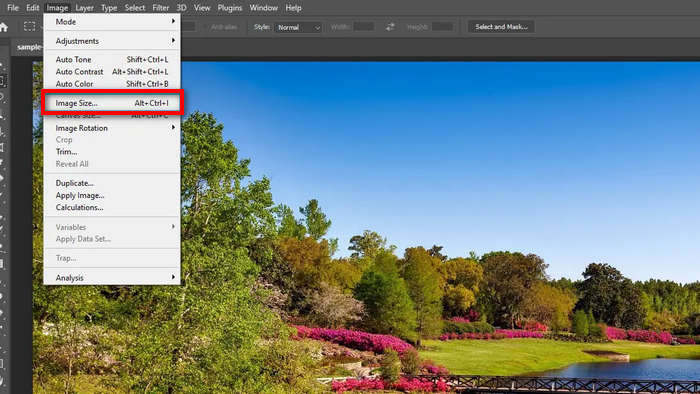
Step 3. Now, in the image dialogue box, set your desired resolution. After that, set your target Height and Width values. Take note that this is in Pixels. Once done, just click the OK button.
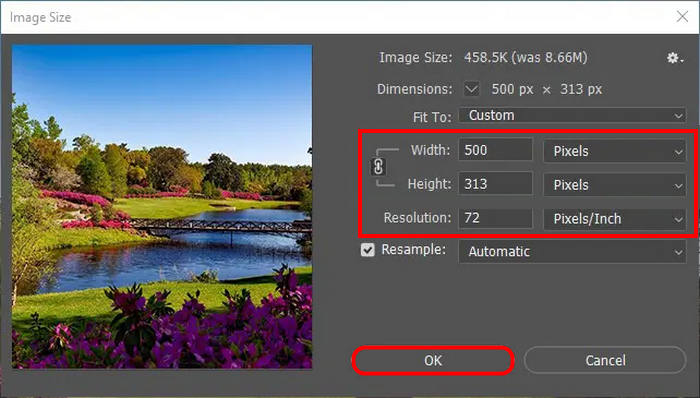
Step 4. To save your file, go to the File tab and choose Save a copy in the menu.
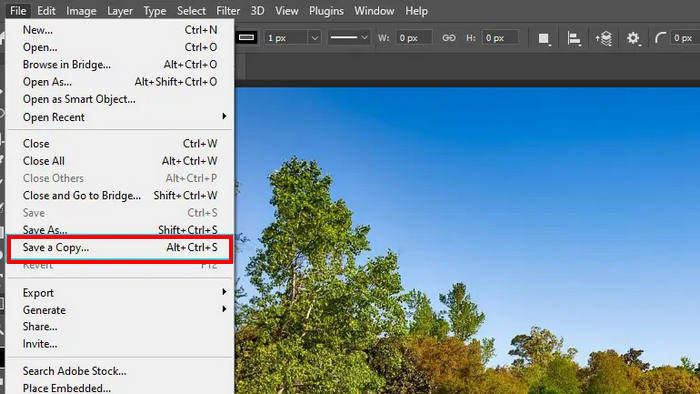
Step 5. After clicking the Save button, you’ll see a JPEG options box. From there, you can easily adjust the image quality of your image by sliding the bar in the Image Options section. Once done, click OK to save.
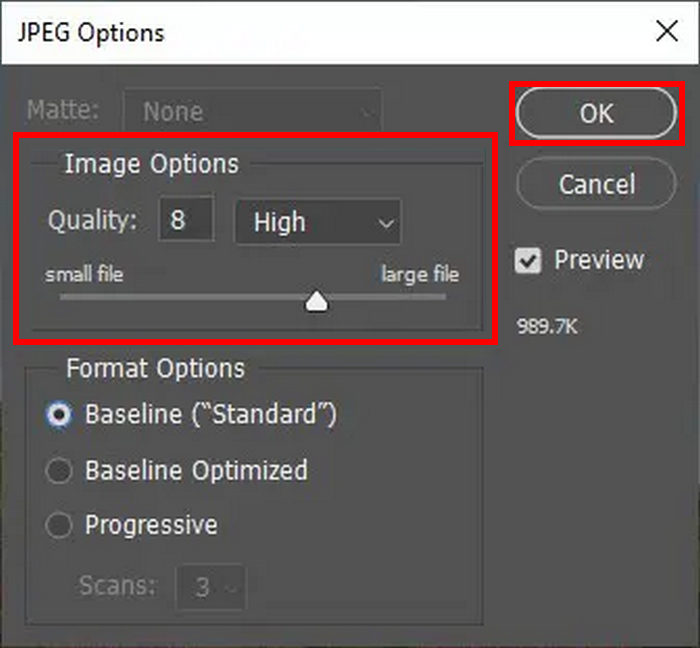
With this method, you can easily change the compression ratio of your photo. However, this can be a little complicated for some, and new users need to avail subscription to enjoy its full features.
Part 3. Bonus: Compress Image Without Losing Quality
FVC Free Image Compressor is a free online image compressor tool that reduces the image size but leaves no obvious quality loss in the output. Compared to some compressor tools, this one has great optimization and compression algorithms, ensuring the best quality resolution of the compressed photo.
Here’s how to compress photos using FVC Free Image Compressor
Step 1. First, you need to go over the official website of FVC Free Image Compressor.
Step 2. After that, click Upload Images to import the photos you want to compress. This tool automatically compresses your photos.

Step 3. Wait for the compression process to finish. Once done, you’ll see a bar status stating it’s finished and information on the before-and-after size of the compressed image. After that, click Download All to save your image.
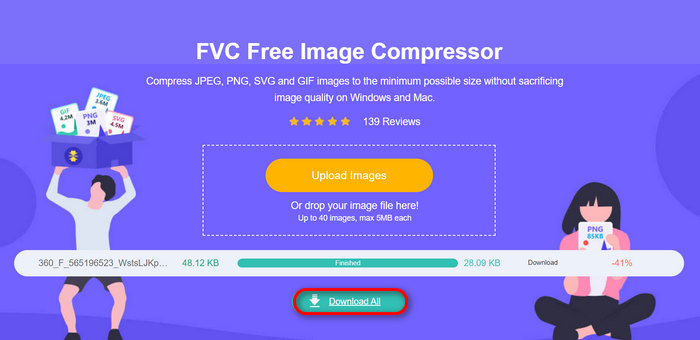
If you want to easily compress your photos, using an FVC Free Image compressor tool is a great alternative. You’ll only need to do one click in order to compress them, and everything is ensured that your photos are well compressed in size and quality.
Part 4. FAQs about Photo Compression Ratio
How to compress a photo to a ratio of 20:1?
How do I find the compression ratio of a photo?
What is the compression ratio of a JPG file?
Is there a limit to how much you can compress a photo?
Conclusion
Understanding and adjusting the photo compression ratio is essential for optimizing images to balance quality and file size. Adobe Photoshop offers a powerful way to manage this, providing fine-tuned control over image quality. For those seeking simpler solutions, tools like FVC Free Image Compressor offer efficient alternatives.
Take control of your image optimization now! Try Adobe Photoshop for advanced editing or use FVC Free Image Compressor for quick and easy compression.



 Video Converter Ultimate
Video Converter Ultimate Screen Recorder
Screen Recorder
